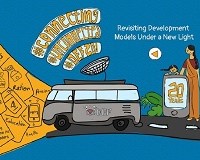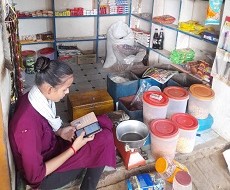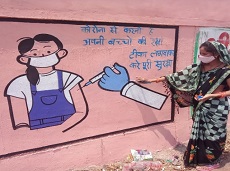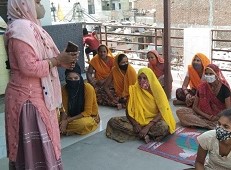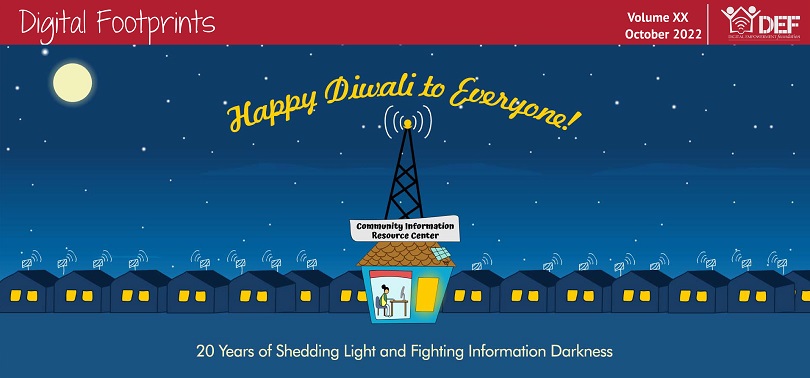

The Digital Empowerment Foundation has always believed in a bottom up approach. All our programs are developed with consultation with stakeholders at the ground level. From district coordinators to SoochnaPreneurs, we regularly speak with them to understand the needs and requirements of the communities we work with. This is what has made our various models successful. Across all pillars from access and infrastructure to research and advocacy, we have ensured the voices of our communities are the loudest. Instead of working for communities, we work with communities to ensure their participation as it helps us maximize impact. Over the last 20 years this policy has helped us build trust with people from 6,000 villages across the country. Read More


The line between providing government services like Google predicts your next possible search comes at a huge trade-off. Clearly, the line between a techno-utopia and a surveillance dystopia can be really thin. India needs a proper data protection law drafted carefully drafted with due consultations with stakeholders. Let’s start by running down some numbers. It is a fact that India is both, one of the most connected countries and one of the most unconnected countries. For example, internet users do not number more than 700 million of India’s population of 1.35 billion. Of these, only 300 million people use the internet regularly; the rest are either token users or, as is called, not ‘habitual users’. Read More


Digital Empowerment Foundation (DEF) with the support of US India Policy Institute (USIPI) set up a Community Information Resource Centre (CIRC) in the remote village of Donabaghatta in Karnataka. The centre is providing digital literacy, digital skilling and access to government entitlements to the community. The centre is run by a SoochnaPreneur who provides the following services: E-governance, Digital finance, Tele-health Digital education. The centre was established in January 2022 and many students have successfully completed the basic and advanced computer courses. One of the students, Sahil comes from an economically backward family. Read More
According to experts, an estimated half a billion women still lack access to education and tens of millions of girls around the world are unable to access education and unlikely to enroll in school, thus hampering the overall growth and development of the girls. And yet, there is sufficient evidence to show that educated women create a ripple effect. We face huge inequalities in the education system of our country. Despite many policies and campaigns taken up by the government, young girls and women still lack access to basic education resulting in exclusion from employment opportunities. Selvarak Rajyalaxmi, who is a resident of Paravada block, Andhra Pradesh, was facing the brunt of gender discrimination in the education system. Read More

The education sector was badly affected by the pandemic and with the reopening of schools institutions are facing new challenges. Students are mentally stressed because they have not been regularly going to school for so long. Now along with their education, their mental and physical health has also become a concern. A workshop was organized for 62 students of Arduka village’s government senior secondary school and the Falhul Amin School in Bharatpur district. The workshop was on Career counseling, Time management, Mental stress. The school principal and counselor were also part of the workshop and addressed the students on some of the major issues that they are facing in their education post lockdown. At the end of the session the school’s toppers were felicitated by DEF. Read More
Deepali Soni is a native of Meerapur Village of Barabanki district of Uttar Pradesh. In her village, there was a digital divide between genders and access to smartphones. After receiving digital literacy training, she is now capable of operating a smartphone and is acclimated to working with useful applications like WhatsApp and Facebook. She owns a general store and wishes to add more items so the community members can come to purchase their everyday amenities from her store. After struggling with customer service, she decided to purchase a new phone and get digital literacy training to facilitate better services. Once Deepali had access to digital media tools for development and empowerment, she created an account on MeraBills and operates it regularly for her daily Kirana store needs and maintenance. Read More
Nirmala Chandel resides in Kumbharaj Tehsil, about 70km away from Guna district. After a few years of marriage, her husband left her with the responsibility of nurturing her 8-year old son alone. She owns a smartphone but was unaware of the many advantages and was using it just as an emergency calling device. One of her community members made her aware of Project Revive and the way her life can change if she becomes digitally literate. Since she had become the sole breadwinner for her family, she established a grocery store. As a trainee with Project Revive, she gained knowledge about digital financial literacy. During this learning journey, she received many benefits from her smartphone and came to know about Google Assistant, learned to do online transactions on the phone, learnt how to do online transactions on the phone through Google. Read More

The aim of the Digital Empowerment Foundation is to bridge the information gap that exists in India and more often than not we choose to use digital tools to bridge this gap. Under the Digital Strengthening of Displaced Populations Program, an initiative of Microsoft and DEF a workshop was conducted to increase awareness about various government schemes and entitlements that the community is eligible for. The session took place at a Community Information Resource Centre (CIRC) in Mangolpuri, Delhi. The session was organized for women and the transgender community with the objective of facilitating linkages with government schemes by bridging the information gap. The government initiates several schemes for the people, however, that information doesn’t always reach the people. Read More

Here is a testimonial from one of our 885 COVID Warriors Kiren Sahu from Raipur, Chhattisgarh working towards busting fake news and misinformation and providing the right information to their communities. “I have done wall paintings related to COVID-19 at various intersections of my village so that more people can see it. I have not limited myself to spreading COVID related information, in fact I have built a strong relationship with my community so that I can bust the myths and misinformation that they believe in. The youth in my village have stood by me and helped me in disseminating the right information to my community. This created a more positive environment in the village and people were more confident about fighting the virus off. Read More
This is a testimonial from Poonam Bai, DEF’s SoochnaPreneur from Alwar. “When the news of the COVID-19 pandemic broke we had to suffer a lot because of all the fake news that came with it. Even when the vaccine was introduced people were so apprehensive about it. It was a huge challenge for me to persuade everyone to take the vaccine. Misinformation and fake news in my opinion turned out to be more dangerous than the pandemic itself multiple times. For the longest time people didn’t even believe that it was a disease; they would refuse to wear masks. Through youth groups, community meetings, announcements and door to door meetings I explained to people about the reality of the pandemic and the ways to fight it. Read More

Let’s start by running down some numbers. It is a fact that India is both, one of the most connected countries and one of the most unconnected countries. For example, there are only 700 million internet users out of India’s population of 1.35 billion. Of these, only 300 million people use the internet regularly; the rest are either token users or, as is called, not ‘habitual users’. Another perspective on internet uses in India is that about 800 million people live in rural areas, and smartphone penetration in rural India is not more than 300 million. It is not contested that a smartphone is one of the more apt device to use the internet for any purpose. Therefore, in terms of sheer numbers and scale of availability of digital Infrastructure, at least 700 million Indians do not have any digital infrastructure or digital means to conduct any work online. Read More
For over a hundred and fifty years, from 1850 to 2013, India had a telegraph service- one that many would remember before the age phones became cheap and ubiquitous. Under the British Raj, telegraph offices were set up, and trans-country services were run. While unrest and opposition to the colonial government had already existed, it was by 1857 that the colonial government faced a striking blow- in the 'first' major uprising and mutiny recorded as the First War of Independence. As the mutinies and rebellions continued, in 1885 the colonial government passed a legislation, the India Telegraph Act- because quickly transmitting information, and intercepting rebels' communications was key to holding power over the subcontinent. The act authorised law agencies to intercept communications in cases where they deem it necessary. Read More
Technology can solve issues of teacher training, data-based decision-making, remediation and so on. But a one-size-fits-all approach won’t work. Programmes must adapt to local needs and diverse gap areas. This week's TypeRight is based on the opinion piece in Hindustan Times, along with some comments and responses. First, some news from this week that gives a scale of the money that went into edtech this year. However, in another side of things, it doesn't seem like profits are close to be seen. The pandemic has probably brought upon us another learning crisis. South Asia saw education levels fall down from pre-pandemic levels of 60% to a 78%. These predictions are part of a preliminary analysis from an upcoming World Bank Report that estimates this global catastrophe as having delivered the worst shock to the educational system seen in recorded history. India, where learning outcomes have been sub-par saw it decline further with the gap between private and public-school education widening. Read More


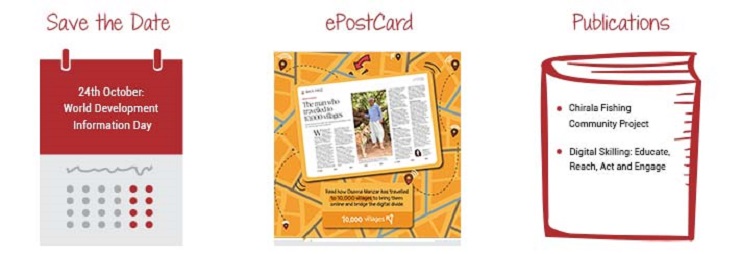

This month we continued with the A-CODE DEFDialogue Series. Community Network XChange was also held during this month; the recording for which can be found here:

Roman is an unusual name for a baby but when a friend of the family suggested it, his parents embraced it. (The same friend suggested the name Ruken for their younger son.) Roman, who is now 21, certainly turned out to be an unusual individual. At the time of his birth the family lived with his grandparents in Karuvadikuppam, 8 km from Puducherry (Pondicherry). Kalaivanan (50) is a mason and Vasanthi (48) a housewife. The couple sensed that “something was wrong” with Roman but only found out later that he had Cerebral Palsy (CP) and a mild intellectual disability. (CP is a neurological disorder leading to limitation or loss of function and mobility.) Roman was a student at Queen Mary’s School in Puducherry till Class 4 and joined Vijayanjali School from Class 5 till Class 10. At school, his teachers treated him well but the other students would occasionally tease him for his disability. That, however, did not deter Roman, who says that he would not take to heart or feel dejected by the taunts of his schoolmates. This positive spirit is Roman’s armour that helps him navigate life with supreme self-confidence. Roman says that he would understand the subjects taught at school, but his physical impairment impacted his writing skills and resulted in his scoring low marks. Read More
With the onset of the third wave we are crowdfunding digital devices so that underprivileged students are not deprived of education like they were during the first two waves of the pandemic.
info@defindia.org | def@defindia.net
You are receiving our newsletter because you opted-in for the purpose of receiving Digital Footprints, a monthly newsletter on digital development. If you wish to withdraw your consent and stop hearing from us, simply click here to unsubscribe
